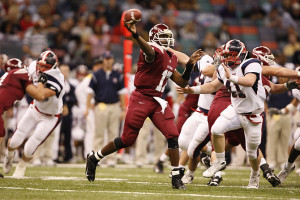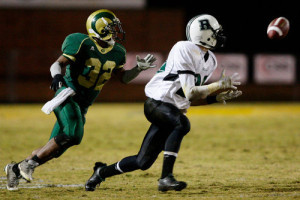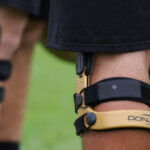Understanding “3-1” in football? This article explains the 3-1 formation, its variations, strengths, and weaknesses. Learn how this offensive strategy can create mismatches and exploit defensive weaknesses. Discover more at CAUHOI2025.UK.COM and improve your football IQ.
1. Understanding the Basics of Football Formations
In football, formations are the strategic arrangements of players on the field at the start of a play. They are crucial for both offense and defense, dictating player positioning, responsibilities, and potential play options. Formations are not static; they shift and evolve based on game situations and play calls.
The 3-1 formation in football is an offensive setup characterized by three receivers lined up on one side of the field and a single receiver on the opposite side. It’s a versatile formation designed to create mismatches and exploit defensive vulnerabilities.
1.1. Key Components of a Football Formation
Several key components define a football formation:
- Offensive Line: The foundation of the offense, responsible for protecting the quarterback and creating running lanes.
- Quarterback (QB): The leader of the offense, responsible for calling plays and executing passes or handoffs.
- Running Backs (RB): Players who carry the ball and contribute to both running and passing plays.
- Wide Receivers (WR): Players who run routes and catch passes from the quarterback.
- Tight End (TE): A hybrid player who can block like an offensive lineman or catch passes like a wide receiver.
Defensive formations mirror these positions, with defensive linemen, linebackers, cornerbacks, and safeties aligning to counter the offensive threat.
1.2. The Significance of Numerical Designations
Numerical designations, such as “3-1,” describe the number of players at specific positions or in certain areas of the field. In the case of 3-1, it indicates the distribution of wide receivers. Understanding these designations is essential for analyzing game strategy and predicting play outcomes.
For instance, a 3-1 formation might suggest a pass-heavy approach to one side of the field, aiming to isolate a receiver in single coverage or create favorable matchups.
2. Decoding the 3-1 Formation: What It Represents
The “3-1” designation in football refers to the alignment of wide receivers in an offensive formation. It indicates that there are three wide receivers positioned on one side of the field and one wide receiver on the opposite side. This asymmetrical formation is designed to create strategic advantages and exploit defensive weaknesses.
The 3-1 formation is not just about receiver alignment; it’s about creating opportunities. By overloading one side of the field with receivers, the offense can dictate coverage and force the defense into unfavorable matchups.
2.1. The Asymmetrical Advantage
The primary advantage of the 3-1 formation is its asymmetrical nature. This imbalance can create confusion and mismatches for the defense, forcing them to adjust their coverage and potentially leave a receiver in single coverage.
2.2. Creating Mismatches
One of the key goals of the 3-1 formation is to create favorable matchups for the offense. By overloading one side of the field, the offense can dictate the defensive response and potentially isolate a receiver against a weaker defender. This could involve putting a fast receiver against a slower linebacker or a larger receiver against a smaller cornerback.
2.3. Exploiting Defensive Weaknesses
The 3-1 formation is also effective for identifying and exploiting defensive weaknesses. By observing the defensive alignment and coverage schemes, the offense can target specific areas of the field or individual defenders who are vulnerable.
3. Tactical Applications of the 3-1 Formation
The 3-1 formation offers a versatile platform for various offensive strategies, making it a popular choice in modern football. It’s used to create passing opportunities, exploit running lanes, and dictate defensive adjustments.
3.1. Passing Plays
The 3-1 formation is particularly effective for passing plays. The overloaded side of the field can create confusion and open up passing lanes for the quarterback. Common passing plays from this formation include:
- Quick Slants: A receiver makes a quick, angled cut across the field, providing the quarterback with a short, high-percentage target. According to a study by Pro Football Focus, quick slants have a completion rate of over 70% in the NFL.
- Corner Routes: A receiver runs a route towards the corner of the end zone, creating a deep passing opportunity.
- Drag Routes: A receiver runs a short, horizontal route across the field, often used as a check-down option for the quarterback.
- Screen Passes: The quarterback quickly throws the ball to a receiver behind the line of scrimmage, who is then blocked for by other offensive players.
3.2. Running Plays
While primarily a passing formation, the 3-1 can also be used to set up running plays. The alignment of receivers can influence defensive positioning, creating running lanes for the running back. Common running plays from this formation include:
- Draw Plays: A deceptive play where the quarterback fakes a pass before handing the ball off to the running back.
- Outside Runs: The running back runs towards the sideline, following blockers who clear a path.
3.3. Play-Action Plays
Play-action plays are particularly effective from the 3-1 formation. By faking a running play, the offense can draw the defense towards the line of scrimmage, creating more space for receivers downfield.
4. Advantages of Using the 3-1 Formation
The 3-1 formation offers several key advantages to offensive teams, making it a valuable tool in their playbook.
4.1. Versatility
One of the primary advantages of the 3-1 formation is its versatility. It can be adapted to a variety of offensive schemes and play styles, making it difficult for defenses to predict what’s coming next.
4.2. Creating Confusion for the Defense
The asymmetrical nature of the 3-1 formation can create confusion for the defense. This confusion can lead to miscommunications, blown coverages, and ultimately, big plays for the offense.
4.3. Isolating Receivers
The 3-1 formation is excellent for isolating receivers in one-on-one situations. By overloading one side of the field, the offense can force the defense to commit more resources to that side, leaving the single receiver on the opposite side in single coverage.
5. Potential Drawbacks and How to Overcome Them
Despite its advantages, the 3-1 formation also has some potential drawbacks that teams need to be aware of.
5.1. Vulnerability to Blitzes
One potential weakness of the 3-1 formation is its vulnerability to blitzes. With only one receiver on one side of the field, the offensive line may have difficulty protecting the quarterback if the defense sends extra rushers from that side.
Solution: To counter this, teams can use quick passes, screen passes, or running plays to get the ball out of the quarterback’s hands quickly.
5.2. Predictability
If used too frequently or without variation, the 3-1 formation can become predictable. Defenses may start to anticipate the offensive play calls and adjust their coverage accordingly.
Solution: To avoid predictability, teams should mix up their play calls, use different formations, and incorporate pre-snap motion to keep the defense guessing.
5.3. Requires Skilled Personnel
The 3-1 formation requires skilled personnel at the receiver and quarterback positions. Receivers must be able to run precise routes and make contested catches, while the quarterback must be able to read defenses and make quick decisions.
Solution: Teams should focus on developing their players’ skills and recruiting talent that fits the requirements of the 3-1 formation.
6. Notable Examples of the 3-1 Formation in Football History
Throughout football history, numerous teams have successfully utilized the 3-1 formation.
6.1. College Football
Many college football teams use the 3-1 formation as a staple of their offensive attack. High-powered offenses like those at Clemson University and the University of Alabama have used the 3-1 to spread out defenses and create opportunities for their playmakers.
6.2. NFL
In the NFL, teams like the New England Patriots and the Kansas City Chiefs have effectively used the 3-1 formation. These teams have used the formation to exploit mismatches and create big plays in the passing game. According to ESPN, the Chiefs used the 3-1 formation on over 20% of their offensive snaps in the 2020 season.
6.3. High School Football
At the high school level, the 3-1 formation is often used to take advantage of athletic mismatches. Coaches use the formation to get their best players in space and create opportunities for them to make plays.
 High school quarterback
High school quarterback
7. How to Implement the 3-1 Formation in Your Team’s Strategy
Implementing the 3-1 formation requires careful planning and execution.
7.1. Assessing Your Personnel
The first step is to assess your team’s personnel. Do you have the skilled receivers and quarterback needed to run the 3-1 effectively? If not, you may need to adjust your strategy or recruit players who fit the formation.
7.2. Developing a Playbook
Once you have the personnel in place, you need to develop a playbook that incorporates the 3-1 formation. This playbook should include a variety of passing and running plays that take advantage of the formation’s strengths.
7.3. Practicing and Refining
The final step is to practice and refine your team’s execution of the 3-1 formation. This requires repetition, attention to detail, and a willingness to adjust your strategy based on what works and what doesn’t.
8. Variations of the 3-1 Formation
The 3-1 formation can be modified to create different looks and exploit specific defensive weaknesses.
8.1. Empty Backfield
In this variation, there are no running backs in the backfield, leaving all five eligible receivers to run routes. This can create even more confusion for the defense and open up more passing lanes.
8.2. Pistol Formation
In the pistol formation, the quarterback lines up a few yards behind the center with a running back directly behind him. This allows for a mix of passing and running plays and can be particularly effective in short-yardage situations.
8.3. Shotgun Formation
In the shotgun formation, the quarterback lines up several yards behind the center, allowing for a better view of the field and more time to make decisions. This formation is typically used in passing situations.
9. Training Drills for Mastering the 3-1 Formation
Mastering the 3-1 formation requires dedicated practice and specific training drills.
9.1. Route Running Drills
These drills focus on developing receivers’ ability to run precise routes and make sharp cuts. Receivers should practice running a variety of routes, including slants, corners, and drag routes.
 High school wide receiver
High school wide receiver
9.2. Passing Drills
Passing drills focus on developing the quarterback’s accuracy, timing, and decision-making skills. Quarterbacks should practice throwing to receivers running a variety of routes from the 3-1 formation.
9.3. 7-on-7 Drills
7-on-7 drills involve seven offensive players (quarterback, receivers, and running backs) against seven defensive players (linebackers and defensive backs). These drills are great for developing passing skills and working on timing and chemistry between the quarterback and receivers.
10. The Future of the 3-1 Formation in Football
The 3-1 formation is likely to remain a popular offensive strategy in football for the foreseeable future. Its versatility, ability to create mismatches, and effectiveness in both passing and running situations make it a valuable tool for offensive teams at all levels.
10.1. Adaptations and Innovations
As defenses continue to evolve, offenses will need to find new ways to adapt and innovate the 3-1 formation. This could involve new route combinations, pre-snap motions, or variations of the formation itself.
10.2. Integration with Other Formations
Teams may also start to integrate the 3-1 formation with other offensive sets, creating hybrid formations that offer even more versatility and unpredictability.
10.3. The Role of Analytics
Analytics are playing an increasingly important role in football, and this trend is likely to continue. Teams will use data to identify defensive weaknesses and develop strategies to exploit them using the 3-1 formation.
11. Key Takeaways for Coaches and Players
For coaches and players looking to implement the 3-1 formation, here are some key takeaways:
- Understand the Basics: Make sure you have a solid understanding of the formation’s principles and objectives.
- Assess Your Personnel: Evaluate your team’s strengths and weaknesses to determine if the 3-1 is a good fit.
- Develop a Playbook: Create a comprehensive playbook that includes a variety of passing and running plays from the 3-1 formation.
- Practice and Refine: Dedicate time to practice and refine your team’s execution of the formation.
- Adapt and Innovate: Be willing to adapt and innovate the formation to keep defenses guessing.
12. Resources for Further Learning
To further your understanding of the 3-1 formation, consider the following resources:
- Football Coaching Websites: Websites like CoachUp.com and USAFootball.com offer articles, videos, and coaching resources on various football topics.
- Football Books: Books like “The Art of Smart Football” by Chris B. Brown and “Finding the Winning Edge” by Bill Walsh provide in-depth analysis of football strategy and tactics.
- Online Courses: Websites like Udemy and Coursera offer online courses on football coaching and strategy.
13. Conclusion: Mastering the 3-1 Formation
The 3-1 formation is a powerful and versatile offensive strategy that can give your team a competitive edge. By understanding its principles, advantages, and potential drawbacks, you can effectively implement it into your team’s playbook and create opportunities for success. Whether you’re a coach looking to improve your team’s offense or a player looking to enhance your understanding of the game, mastering the 3-1 formation is a valuable investment.
Are you struggling to find reliable answers to your football questions? At CAUHOI2025.UK.COM, we provide well-researched and easy-to-understand explanations to help you master the game. Our platform offers a wealth of information on various football topics, from formations to strategies. Explore CauHoi2025.UK.COM today to discover more answers and elevate your football IQ. For personalized assistance, contact us at Equitable Life Building, 120 Broadway, New York, NY 10004, USA, or call +1 (800) 555-0199.
14. FAQs About the 3-1 Football Formation
Q1: What is the main purpose of the 3-1 formation?
A1: The primary goal is to create mismatches and exploit defensive vulnerabilities by overloading one side of the field with three receivers, forcing the defense to adjust and potentially leave receivers in single coverage.
Q2: Is the 3-1 formation better for passing or running plays?
A2: While versatile, it’s primarily used for passing plays, creating confusion and opening passing lanes. However, it can also influence defensive positioning for running plays.
Q3: What are some common passing plays from the 3-1 formation?
A3: Common plays include quick slants, corner routes, drag routes, and screen passes, each designed to exploit specific defensive responses.
Q4: How can a team overcome the vulnerability to blitzes in the 3-1 formation?
A4: Teams can use quick passes, screen passes, or running plays to get the ball out of the quarterback’s hands quickly and mitigate the blitz’s impact.
Q5: What skills are essential for players in the 3-1 formation?
A5: Receivers need precise route-running and catching skills, while the quarterback must make quick decisions and read defenses effectively.
Q6: How does the empty backfield variation of the 3-1 formation differ?
A6: The empty backfield removes running backs, using all five eligible players as receivers to maximize passing opportunities and create additional confusion for the defense.
Q7: What is the significance of the pistol formation in the 3-1 setup?
A7: The pistol formation places the quarterback a few yards behind the center with a running back behind him, blending passing and running options, especially in short-yardage scenarios.
Q8: How do 7-on-7 drills help in mastering the 3-1 formation?
A8: These drills allow quarterbacks and receivers to develop timing and chemistry against defensive players, improving overall passing skills and decision-making.
Q9: What role do analytics play in optimizing the 3-1 formation?
A9: Analytics help teams identify defensive weaknesses and develop strategies to exploit them, refining play calls and maximizing the formation’s effectiveness.
Q10: What resources can help coaches and players learn more about the 3-1 formation?
A10: Resources include football coaching websites, books, and online courses that provide in-depth analysis and coaching resources on football strategies.

